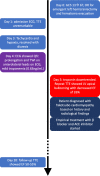Case Report: Takotsubo Cardiomyopathy After Traumatic Brain Injury
- PMID: 34603185
- PMCID: PMC8479872
- DOI: 10.3389/fneur.2021.727754
Case Report: Takotsubo Cardiomyopathy After Traumatic Brain Injury
Abstract
Introduction: Takotsubo cardiomyopathy (TCM) or "stress cardiomyopathy" is an uncommon condition characterized by transient cardiac dysfunction with left ventricular apical ballooning in an appropriate clinical context. TCM has been observed in a variety of acute neurological conditions most prominently in patients with aneurysmal subarachnoid hemorrhage and status epilepticus. TCM has only been reported infrequently in association with traumatic brain injury (TBI). Herein we present a patient who developed TCM 3 days after hospital admission with severe TBI. Case Presentation: A 30-year-old male presented to the hospital with an acute subdural hematoma, anisocoria, declining consciousness and CT evidence of uncal herniation after being found down in a hotel room. The patient was taken emergently to the operating room for decompressive hemicraniectomy and hematoma evacuation. On the post-trauma day (PTD) 3, the patient developed acute dyspnea with increased oxygen requirements that improved with diuresis. On PTD 4, nursing staff noted T waive inversions (TWI) on the bedside monitor prompting an electrocardiogram (ECG) that showed a prolonged QTc interval and worsening TWI in leads I, II, aVL, and V2-6. Troponin I level was mildly elevated at 0.63ng/mL. Transthoracic echocardiography (TTE) was subsequently performed and showed a low ejection fraction (EF 26%) with apical hypokinesis and basal hyperkinesis, consistent with TCM. A diagnosis of TCM was confirmed by Cardiology consultation and he was started on a beta-blocker and an ACE inhibitor. Follow-up TTE on PTD 20 showed a normal left ventricular EF. Conclusion: While rarely reported in patients with TBI, TCM developed in an otherwise healthy young male following severe TBI necessitating decompressive hemicraniectomy. TTE should be considered in patients with TBI who have cardio-pulmonary symptoms or unexplained ECG abnormalities.
Keywords: TBI; Takotsubo cardiomyopathy; case report; diagnosis; stress cardiomyopathy; traumatic brain injury.
Copyright © 2021 Wang and Darby.
Conflict of interest statement
The authors declare that the research was conducted in the absence of any commercial or financial relationships that could be construed as a potential conflict of interest.
Figures



References
Publication types
LinkOut - more resources
Full Text Sources
Miscellaneous

